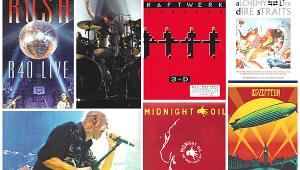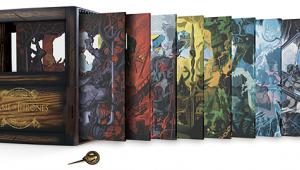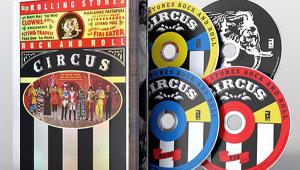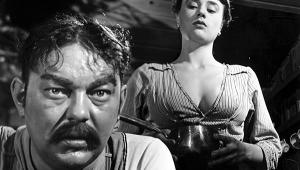The Adventures of Indiana Jones
Harrison Ford, Karen Allen, Paul Freeman, Ronald Lacey, John Rhys-Davies, Denholm Elliot. 115 minutes. 1981. PG.
Picture ***
Sound ** 1/2
Film *** 1/2
Indiana Jones and the Temple of Doom
Harrison Ford, Kate Capshaw, Amrish Puri, Roshan Seth, Philip Stone, Ke Huy Quan. 118 minutes. 1984. PG.
Picture *** 1/2
Sound *** 1/2
Film ***
Indiana Jones and the Last Crusade
Harrison Ford, Sean Connery, Denholm Elliot, Alison Doody, John Rhys-Davies, Julian Glover. 126 minutes. 1989. BR-13.
Picture *** 1/2
Sound ****
Film ****
Indiana Jones
Bonus material. 187 minutes. 2003. NR.
All
Directed by Steven Spielberg. Aspect ratio: 2.35 (anamorphic). Dolby Digital 5.1 Surround (English), Dolby Surround (French, Spanish), THX. Four DVDs. Paramount Home Entertainment 06125. $69.98.
In the mid-1970s, George Lucas, fresh off the modest success of American Graffiti, was pondering his next project. He had two ideas: a space opera, and the adventures of an archeologist. Both would be pure escapism, the latter, in particular, modeled after the old Republic serials Lucas had grown up with.
 That little space opera, and its first sequel, ultimately came first. But Lucas didn't forget the other concept, and when he talked his close friend Steven Spielberg into directing it, Raiders of the Lost Ark—the adventures of archeologist and action hero Indiana Jones—barreled onto the big screen. It became a phenomenon and spawned two sequels.
That little space opera, and its first sequel, ultimately came first. But Lucas didn't forget the other concept, and when he talked his close friend Steven Spielberg into directing it, Raiders of the Lost Ark—the adventures of archeologist and action hero Indiana Jones—barreled onto the big screen. It became a phenomenon and spawned two sequels.
But while the Indiana Jones sagas have long been available on home video, including laserdisc releases dating back to the mid-1980s for the earlier films, Spielberg and Paramount bided their time on the DVDs. We don't pretend to know why, apart from some limited restoration. I'd hate to think that the films were badly preserved; they aren't that old, but apparently a lot of dirt spots had to be erased, as did at least one bad scratch on Raiders. Subtle retouching was also performed to remove a few minor special-effects glitches that crept into the original theatrical and video releases.
But that's all history now. The movies are finally available in this four-DVD set—one for each film and a fourth for the special features. And while the first film has been renamed—presumably for commercial reasons—Indiana Jones and the Raiders of the Lost Ark on the boxed set's artwork, it will always be Raiders of the Lost Ark to its fans. That's still the name that appears in the film's title sequence, and that's what I'll call it here.
Raiders of the Lost Ark is set in 1936. Archeologist Indiana Jones learns that the Nazis are on the verge of discovering the fabled Ark of the Covenant. Racing to beat them to an important missing link in the search, he travels first to Nepal, where he meets up with old flame Marion Ravenwood (Karen Allen). Racing against time, Indiana and Marion travel on to Egypt, and finally to a top-secret Nazi submarine base on a remote island for the big finish. Full of the sort of cliffhanger moments that characterized those old serials that Lucas loved, you can almost spot the places where a "To Be Continued Next Week" title card should go: Indy escaping the angry natives; Indy's head pinned to a bar as flames rush toward him; Marion seemingly killed in an explosion . . . and on and on. But here we don't have to wait until next week for the resolutions.
If Raiders is the film that fans of the series are most excited about, Indiana Jones and the Temple of Doom is probably their least favorite. Dark almost to a fault (according to the extra features, it turned out darker than even the filmmakers anticipated), this film actually resulted in the creation of the PG-13 rating, though curiously it's still rated PG. But although the scenes that triggered the new rating are comparatively mild by today's standards, parents would still be wise to treat the film as PG-13.
With its somber tone and occasional cringe-inducing moments, Temple of Doom lacks the appealing mix of humor and lightweight escapism that distinguishes Raiders. It's about the search, in a remote part of India, for some magic stones that are the source of unlimited power (sounds familiar). They've fallen into the hands of an obscure cult that engages in human sacrifice. What little humor there is comes courtesy of an obnoxious kid and a wimpy heroine who screams often, whines incessantly, and frets over a broken fingernail. Where is Karen Allen's feisty Marion Ravenwood when we need her?
Still, there's plenty of action. The mine-car chase, in particular, has become a classic and is, by itself, reason enough to own the film. Most of it was shot with miniatures. But much of the fight scene that leads up to it, and the limited live action in the chase itself, was actually shot with Harrison Ford's stunt double, apart from a few close-ups. Ford himself, who otherwise might have done at least some of the stunts, was back in L.A. recovering from back surgery for an injury sustained earlier in the shoot.
It was a long five years after Doom before the third installment of Indiana Jones' adventures made it to the screen, in 1989. In Indiana Jones and the Last Crusade, Jones tracks down clues to the location of the Holy Grail, aided by his father's diary and, ultimately, by his father himself, who has been obsessed with the subject his whole life. Of course, the Nazis want to possess the grail for the same reason they wanted the Ark—as a source of "unspeakable power." But they run into Indiana Jones. They should have learned by now not to mess with him.
With all due respect to Raiders, revisiting all three titles at once on DVD has convinced me that The Last Crusade is, in all respects but one, the best of the three. It has all the exciting action of the first, a similar, mystical plot, evil Nazis, and an even defter balance of humor and drama. But most important, it has genuine character development, thanks largely to the presence of Sean Connery as Indiana's father. Only a weak female lead (have I already mentioned that Karen Allen should have been brought back for at least one of the sequels?) mars the otherwise tight script.
All three films have been beautifully restored and given outstanding DVD transfers. There's no visible noise, the color is superb, and the shadow detail is excellent. If the overall results aren't quite perfect visually, credit that to the original photography, along with a touch of edge enhancement. The latter is most visible in Raiders and in the opening sequence of Crusade. It's comparatively mild, however, and is more obvious with a large front-projection system than on a smaller rear-projection set. There's also a tendency for medium and long shots to be a little soft compared to the best DVDs we've seen, though close-ups can often be startlingly crisp.
While the sound in Raiders is dynamic and punchy, it's a little dated. The dialogue, largely re-recorded in post-production, often sounds canned and poorly matched to the onscreen environment. The bass is respectable, but clearly from the pre-digital age. The rather flat soundstage clusters around the front speakers rather than forming a seamless spread. The sound is also a little bright, but cinema equalization (I used THX Re-Eq) helped tame it. On the positive side, the surrounds may not be particularly discrete but do provide a nice ambience. And John Williams' signature fanfares sound excitingly brassy and muscular.
The sound is more up to date in The Temple of Doom, and really shines in The Last Crusade. With the latter, in particular, there's a more solid bottom end, more active surrounds, and—apart from the very top end, which could still profit from some cinema EQ—a smooth spectral balance. The score of Crusade is also beautifully recorded—it's the best of the three films in that respect—with an image spread evenly between the front speakers and a genuine sense of depth.
John Williams' scores for all three films play an important role in their overall impact, and while he's written great music for many films, he never did better work in the action genre than he did for the Indiana Jones series. One of the four featurettes on disc 4 is devoted to his music for the trilogy. In addition, there are featurettes on the stunts, the sound, and the special effects.
Even better is a "Making of" documentary that runs at least two hours. The viewer can select segments dedicated to each of the films, or choose "Play All." It's full of interesting information, including: screen tests, some for actors who did not, for various reasons, end up playing parts in the finished films; details about Ford's back injury during Temple of Doom; and the genesis of some of the characters' names: Indiana was the name of George Lucas' dog, and Marion Ravenwood came from the name of screenwriter Lawrence Kasdan's wife (Marion) and a street in Los Angeles (Ravenwood). Disc 4 also includes trailers and DVD-ROM features.
I suspect that Paramount will someday make each of these titles available independently, though that may require remastering to put at least some special features on each movie disc (apart from the current DVD-ROM access to the Indiana Jones website). But why wait? You can have all three now.
Postscript: We haven't seen the end of Indiana Jones—his last hurrah is now in the planning stage. It will be interesting to learn what the filmmakers have in mind for the fourth installment, currently scheduled for 2005 release. While Indy's tank-battling days would seem to be behind him, who knows? Perhaps a plot set in the late 1940s, with remnants of the Nazi leadership attempting to steal back the Ark and use it to help revive their cause? But judging from the closing shot of Raiders, it was better hidden in Washington, DC, than it was in Egypt!—TJN
- Log in or register to post comments






























































